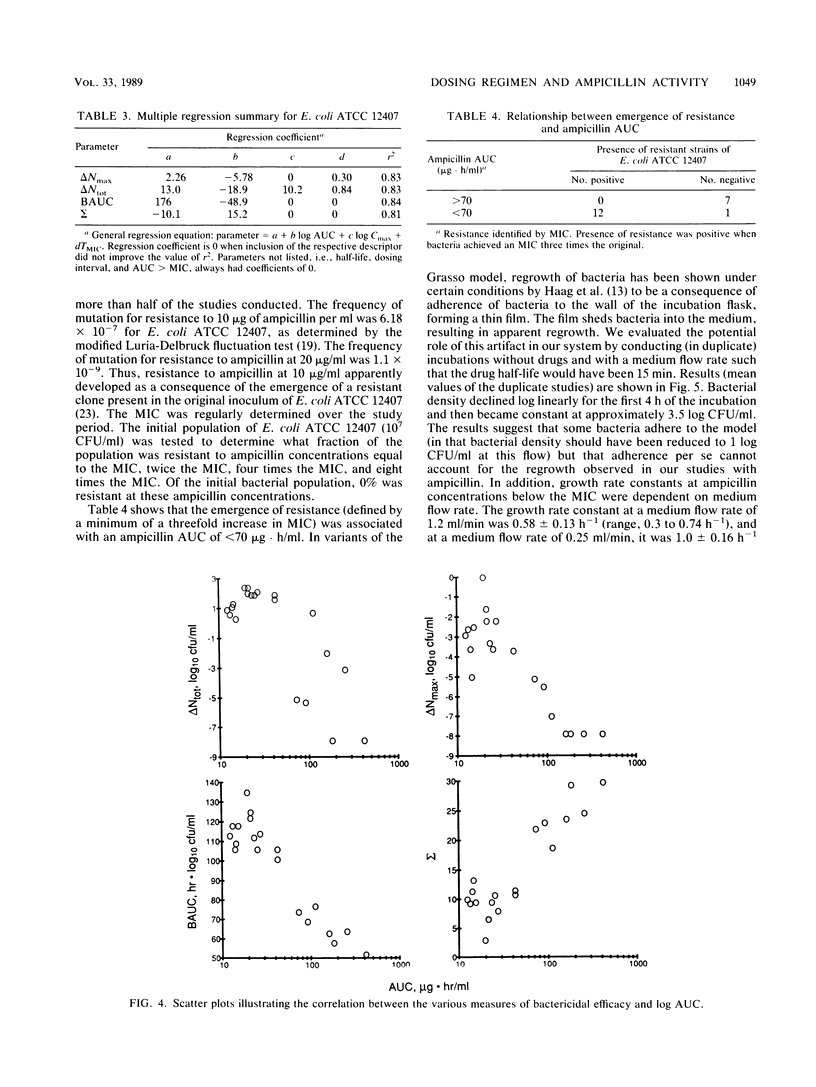Abstract
An in vitro flow model was used to examine the influence of peak concentration (Cmax), the area under the antibiotic concentration-time curve (AUC), the magnitude of AUC above the MIC, and the aggregate time the antibiotic concentration exceeds the MIC (TMIC) on the bactericidal effect of ampicillin against Escherichia coli ATCC 12407. Bacteria in the log phase were exposed to therapeutically realistic drug regimens. Ampicillin concentration and bacterial density (CFU per milliliter) were measured over time. Four parameters reflecting bactericidal activity were quantitated: difference between initial and minimum and initial and final bacterial densities, area under the bacterial density-time curve, and a fourth parameter, sigma, which is a function of these three. Multiple regression analysis confirmed AUC as the major factor in predicting bactericidal activity. An AUC of greater than 70 micrograms.h/ml correlated with the lack of emergence of resistance.
Full text
PDF





Selected References
These references are in PubMed. This may not be the complete list of references from this article.
- Bayer A. S., Norman D., Kim K. S. Efficacy of amikacin and ceftazidime in experimental aortic valve endocarditis due to Pseudomonas aeruginosa. Antimicrob Agents Chemother. 1985 Dec;28(6):781–785. doi: 10.1128/aac.28.6.781. [DOI] [PMC free article] [PubMed] [Google Scholar]
- Bennett J. V., Brodie J. L., Benner E. J., Kirby W. M. Simplified, accurate method for antibiotic assay of clinical specimens. Appl Microbiol. 1966 Mar;14(2):170–177. doi: 10.1128/am.14.2.170-177.1966. [DOI] [PMC free article] [PubMed] [Google Scholar]
- Blaser J., Stone B. B., Groner M. C., Zinner S. H. Comparative study with enoxacin and netilmicin in a pharmacodynamic model to determine importance of ratio of antibiotic peak concentration to MIC for bactericidal activity and emergence of resistance. Antimicrob Agents Chemother. 1987 Jul;31(7):1054–1060. doi: 10.1128/aac.31.7.1054. [DOI] [PMC free article] [PubMed] [Google Scholar]
- EAGLE H., FLEISCHMAN R., LEVY M. "Continuous" vs. "discontinuous" therapy with penicillin; the effect of the interval between injections on therapeutic efficacy. N Engl J Med. 1953 Mar 19;248(12):481–488. doi: 10.1056/NEJM195303192481201. [DOI] [PubMed] [Google Scholar]
- EAGLE H., FLEISCHMAN R., MUSSELMAN A. D. Effect of schedule of administration on the therapeutic efficacy of penicillin; importance of the aggregate time penicillin remains at effectively bactericidal levels. Am J Med. 1950 Sep;9(3):280–299. doi: 10.1016/0002-9343(50)90425-6. [DOI] [PubMed] [Google Scholar]
- Gerber A. U., Brugger H. P., Feller C., Stritzko T., Stalder B. Antibiotic therapy of infections due to Pseudomonas aeruginosa in normal and granulocytopenic mice: comparison of murine and human pharmacokinetics. J Infect Dis. 1986 Jan;153(1):90–97. doi: 10.1093/infdis/153.1.90. [DOI] [PubMed] [Google Scholar]
- Gerber A. U., Craig W. A., Brugger H. P., Feller C., Vastola A. P., Brandel J. Impact of dosing intervals on activity of gentamicin and ticarcillin against Pseudomonas aeruginosa in granulocytopenic mice. J Infect Dis. 1983 May;147(5):910–917. doi: 10.1093/infdis/147.5.910. [DOI] [PubMed] [Google Scholar]
- Gerber A. U., Wiprächtiger P., Stettler-Spichiger U., Lebek G. Constant infusions vs. intermittent doses of gentamicin against Pseudomonas aeruginosa in vitro. J Infect Dis. 1982 Apr;145(4):554–560. doi: 10.1093/infdis/145.4.554. [DOI] [PubMed] [Google Scholar]
- Grasso S., Meinardi G., de Carneri I., Tamassia V. New in vitro model to study the effect of antibiotic concentration and rate of elimination on antibacterial activity. Antimicrob Agents Chemother. 1978 Apr;13(4):570–576. doi: 10.1128/aac.13.4.570. [DOI] [PMC free article] [PubMed] [Google Scholar]
- Guggenbichler J. P., Semenitz E., König P. Kill kinetics and regrowth pattern of bacteria exposed to antibiotic concentrations simulating those observed in vivo. J Antimicrob Chemother. 1985 Jan;15 (Suppl A):139–146. doi: 10.1093/jac/15.suppl_a.139. [DOI] [PubMed] [Google Scholar]
- Haag R., Lexa P., Werkhäuser I. Artifacts in dilution pharmacokinetic models caused by adherent bacteria. Antimicrob Agents Chemother. 1986 May;29(5):765–768. doi: 10.1128/aac.29.5.765. [DOI] [PMC free article] [PubMed] [Google Scholar]
- Hunter P. A., Rolinson G. N., Witting D. A. Comparative activity of amoxycillin and ampicillin in an experimental bacterial infection in mice. Antimicrob Agents Chemother. 1973 Sep;4(3):285–293. doi: 10.1128/aac.4.3.285. [DOI] [PMC free article] [PubMed] [Google Scholar]
- Jalling B., Malmborg A. S., Lindman A., Boréus L. O. Evaluation of a micromethod for determination of antibiotic concentrations in plasma. Eur J Clin Pharmacol. 1972 Jun;4(3):150–157. doi: 10.1007/BF00561138. [DOI] [PubMed] [Google Scholar]
- Klaus U., Henninger W., Jacobi P., Wiedemann B. Bacterial elimination and therapeutic effectiveness under different schedules of amoxicillin administration. Chemotherapy. 1981;27(3):200–208. doi: 10.1159/000237978. [DOI] [PubMed] [Google Scholar]
- MILLER A. K., WILMER D. L., VERWEY W. F. Effect of penicillin dosage schedule on treatment of experimental typhoid infections in mice. Proc Soc Exp Biol Med. 1950 May;74(1):62–64. doi: 10.3181/00379727-74-17810. [DOI] [PubMed] [Google Scholar]
- Maugh T. H. A new wave of antibiotics builds. Science. 1981 Dec 11;214(4526):1225–1228. doi: 10.1126/science.7302591. [DOI] [PubMed] [Google Scholar]
- Merrikin D., Rolinson G. N. Antibiotic levels in experimentally infected mice in relation to therapeutic effect and antibacterial activity in vitro. J Antimicrob Chemother. 1979 Jul;5(4):423–429. doi: 10.1093/jac/5.4.423. [DOI] [PubMed] [Google Scholar]
- Olson B., Weinstein R. A., Nathan C., Chamberlin W., Kabins S. A. Occult aminoglycoside resistance in Pseudomonas aeruginosa: epidemiology and implications for therapy and control. J Infect Dis. 1985 Oct;152(4):769–774. doi: 10.1093/infdis/152.4.769. [DOI] [PubMed] [Google Scholar]
- Pearson R. D., Steigbigel R. T., Davis H. T., Chapman S. W. Method of reliable determination of minimal lethal antibiotic concentrations. Antimicrob Agents Chemother. 1980 Nov;18(5):699–708. doi: 10.1128/aac.18.5.699. [DOI] [PMC free article] [PubMed] [Google Scholar]
- Simon H. J., Yin E. J. Microbioassay of antimicrobial agents. Appl Microbiol. 1970 Apr;19(4):573–579. doi: 10.1128/am.19.4.573-579.1970. [DOI] [PMC free article] [PubMed] [Google Scholar]
- White C. A., Toothaker R. D., Smith A. L., Slattery J. T. Correction for bacterial loss in in vitro dilution models. Antimicrob Agents Chemother. 1987 Nov;31(11):1859–1860. doi: 10.1128/aac.31.11.1859. [DOI] [PMC free article] [PubMed] [Google Scholar]


